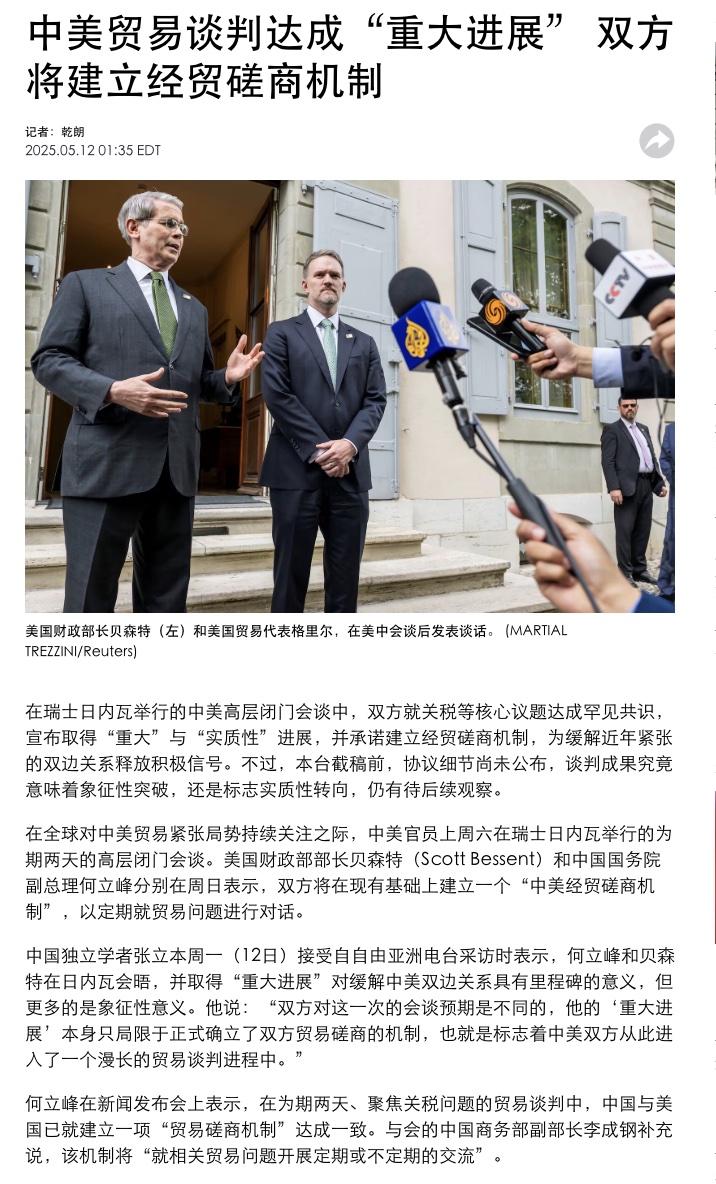Author: Uncle Cat Source: X, @Cato_CryptoM
The two-day Sino-US Swiss meeting finally brought "good news". Both sides stated in major media that this consultation has made "significant progress"
However, we need to clearly know what the progress is?
First of all, this huge progress is based on the mechanism of both sides from "refusing to talk" to the smooth development of "trade consultations". To put it bluntly, from now on, Sino-US trade will formally conduct detailed consultations, and the two sides will frequently negotiate trade details, which is no longer the previous "ice-cold" international relations.
To put it simply, both sides celebrated this trade negotiation - breaking the ice successfully.
So, this trade negotiation is a "symbolic" breakthrough. It is not a breakthrough in essence.
So far, the US tariff on China has been reduced to 30%, and China's tariff on the US has been reduced to 10%. Judging from this data, the US tariff on China is still at a historical high and is relatively radical, while China's tariff on the US has been reduced to a normal level of 10%.

This is not because China is "cowardly", but because China and the United States have different roles and systems in the global supply chain. China is the main supplier, while the United States is the demander. Therefore, the current tariff amount between China and the United States is still at a relatively high level, but this level has changed from the "outrageous" 145% to the "negotiable" 30%.
The 145% from the US side before belonged to the "pretentious" series, which was the big brother scaring the little brother. Now, the two sides are sitting at the negotiating table at the same level, and it is obvious that they respect China's attitude.
Both China and the United States have also stated that they will conduct trade consultations frequently in the future, which is enough to prove this.
For the global economy, the easing of Sino-US trade and the avoidance of decoupling have greatly eased the pressure on the global economy. In the short term, the corresponding safe-haven assets and risk markets will fluctuate greatly.
From the perspective of the global economy and risk markets, this huge progress has solved the Sino-US trade problem. Although the substantive specific tariff policy has not been announced, China and the United States will fall into a "normalized" consultation stage on trade. Whether it is good or bad, the tariff will not have a significant impact on the market.
Afterwards, the macroeconomic level will gradually return to the economy and related economic data from the tariff issue!
The key points after the Sino-US trade negotiations:
A, the key cards imported by China
Agricultural sector, such as soybeans, corn, sorghum, wheat and other products, specific tariff policies
Automobile sector, vehicle imports, such as Ford pickups, Tesla, and related parts
Energy sector, natural gas, crude oil, etc.
Aerospace equipment, Boeing, aviation accessories
Medical equipment, etc.
B, the key cards imported by the United States
High-tech and key manufacturing, such as chips, Huawei's communication technology, current machinery manufacturing and electric vehicles, industrial robots, etc.,
left;">Commodities, such as steel, chemical products, rare earth, etc.
Consumer electronics and mid-range manufacturing products, mobile phones, notebooks, televisions, headphones, etc., also include household appliances
Agriculture and light industry
From the overall details, the reason why the US is worried about the pressure brought by China's exports is that China basically covers the entire industrial chain such as high, medium and low and important resources.
Therefore, the real victory in trade negotiations is still "a long way to go"!

 Anais
Anais






